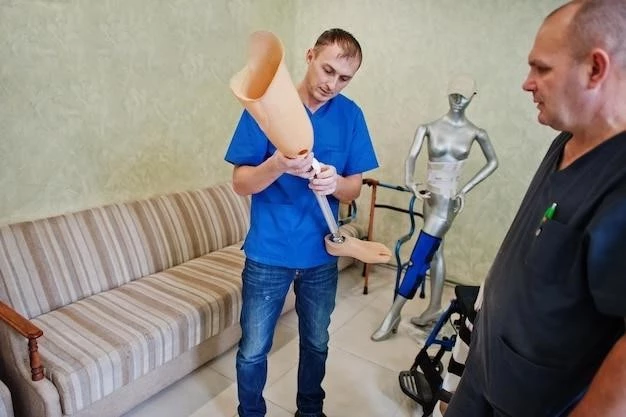Hemifacial Atrophy Progressive
Welcome to our comprehensive guide on Hemifacial Atrophy Progressive‚ a disorder characterized by gradual‚ unilateral facial tissue wasting. This condition‚ also known as Parry-Romberg syndrome‚ poses challenges for those affected by its progressive nature.
Introduction to Hemifacial Atrophy Progressive
Welcome to our comprehensive guide on Hemifacial Atrophy Progressive‚ a disorder characterized by gradual‚ unilateral facial tissue wasting. This condition‚ also known as Parry-Romberg syndrome‚ poses challenges for those affected by its progressive nature.
Individuals with Hemifacial Atrophy Progressive experience a loss of soft tissues in one side of the face‚ leading to visible changes in facial structures and potential functional impairments. The exact cause of this disorder is not fully understood‚ but it is believed to involve a combination of autoimmune‚ genetic‚ and neurological factors.
Commonly‚ the onset of symptoms occurs during childhood or adolescence‚ with the condition worsening over time. The progressive nature of Hemifacial Atrophy Progressive can significantly impact a person’s self-esteem and quality of life‚ making early diagnosis and management crucial.
Throughout this article‚ we will explore the symptoms‚ diagnosis‚ causes‚ neural degeneration‚ and management options for Hemifacial Atrophy Progressive. Understanding the complexities of this disorder is essential in providing support and guidance for individuals and families navigating the challenges it presents.
Understanding the Symptoms
Recognizing the symptoms of Hemifacial Atrophy Progressive is crucial for early detection and management of this progressive disorder. The hallmark feature of this condition is the gradual wasting of soft tissues on one side of the face‚ leading to visible asymmetry in facial structures.
Common symptoms include⁚
- Facial asymmetry⁚ Visible differences in the size and shape of facial features between the affected and unaffected sides of the face.
- Skin changes⁚ Thinning or tightening of the skin on the affected side‚ sometimes accompanied by pigmentation changes.
- Eye involvement⁚ Issues with the eye on the affected side‚ including enophthalmos (sunken eye)‚ ptosis (drooping eyelid)‚ or changes in eye pigmentation.
- Oral manifestations⁚ Changes in dental occlusion‚ gum tissue‚ or overall oral symmetry may be present.
- Neurological symptoms⁚ Some individuals may experience neurological symptoms such as headaches‚ seizures‚ or sensory disturbances on the affected side.
It is essential to consult with a healthcare professional if you or a loved one experience any of these symptoms. Early intervention and appropriate management strategies can help mitigate the impact of Hemifacial Atrophy Progressive on physical and emotional well-being.
Stay vigilant for subtle changes in facial appearance and consult a medical professional for a comprehensive evaluation if you suspect the presence of Hemifacial Atrophy Progressive. Timely diagnosis and proactive treatment can aid in slowing the progression of this condition and improving outcomes for those affected.
Diagnosis of Hemifacial Atrophy Progressive
Diagnosing Hemifacial Atrophy Progressive typically involves a multidisciplinary approach to assess symptoms‚ investigate underlying causes‚ and determine the extent of tissue degeneration. Healthcare providers may utilize a combination of clinical evaluations‚ imaging studies‚ and laboratory tests to establish a diagnosis.
The diagnostic process may include⁚
- Physical examination⁚ A thorough examination of the face‚ head‚ and neck to assess changes in facial symmetry‚ skin texture‚ muscle tone‚ and neurological function.
- Medical history review⁚ Gathering information about the onset of symptoms‚ progression of the condition‚ and any relevant family history of autoimmune diseases or neurological disorders.
- Imaging studies⁚ Techniques such as X-rays‚ CT scans‚ or MRI scans can help visualize changes in facial tissues‚ bone structure‚ and potential involvement of underlying structures.
- Biopsy⁚ In some cases‚ a tissue biopsy may be recommended to evaluate the presence of inflammation‚ tissue damage‚ or autoimmune processes in the affected area.
- Neurological assessment⁚ Assessing neurological function‚ including sensory perception‚ motor control‚ and cranial nerve function‚ to identify any associated neurological symptoms.
It is essential to work closely with healthcare professionals specializing in neurology‚ dermatology‚ and plastic surgery for an accurate diagnosis of Hemifacial Atrophy Progressive. Early and accurate diagnosis is key to implementing appropriate treatment strategies and ongoing management to address the physical and emotional implications of this disorder.
If you suspect the presence of Hemifacial Atrophy Progressive based on symptoms or visual changes in facial structures‚ seek prompt medical attention for a comprehensive evaluation. Collaborating with a knowledgeable healthcare team can help clarify the diagnosis and determine the most effective management plan tailored to your specific needs.
Causes and Genetics
The exact causes of Hemifacial Atrophy Progressive‚ also known as Parry-Romberg syndrome‚ are not fully understood‚ but researchers believe that a combination of factors contributes to the development of this rare condition. While the precise mechanisms remain under investigation‚ several potential causes and genetic factors have been identified.
Possible causes and genetic considerations include⁚
- Autoimmune processes⁚ Some theories suggest that an autoimmune response may target the tissues on one side of the face‚ leading to inflammation‚ tissue degeneration‚ and facial asymmetry.
- Neurological involvement⁚ Dysfunction in the trigeminal nerve or other neural pathways may play a role in the development of Hemifacial Atrophy Progressive‚ affecting tissue innervation and function.
- Tissue degeneration⁚ Progressive loss of fat‚ muscle‚ and connective tissues on one side of the face may result from abnormal tissue degeneration processes‚ impacting facial contour and function.
- Genetic predisposition⁚ While most cases of Hemifacial Atrophy Progressive occur sporadically‚ there is evidence to suggest a potential genetic component that predisposes certain individuals to the condition.
- Connective tissue disorders⁚ In some instances‚ underlying connective tissue disorders or collagen abnormalities may contribute to the manifestation of this syndrome.
Understanding the interplay between autoimmune responses‚ neural degeneration‚ genetic factors‚ and tissue abnormalities is crucial in unraveling the complexities of Hemifacial Atrophy Progressive. Genetic studies and further research are essential to elucidate the underlying mechanisms and potential risk factors associated with this disorder.
Individuals diagnosed with Hemifacial Atrophy Progressive may benefit from genetic counseling to understand the possible hereditary implications and to explore personalized management and treatment options. Collaborating with healthcare professionals knowledgeable about the genetic aspects of this disorder can provide valuable insights and support for individuals and families navigating the complexities of Parry-Romberg syndrome.
Neural Degeneration in Hemifacial Atrophy Progressive
Neural degeneration plays a significant role in the pathogenesis of Hemifacial Atrophy Progressive‚ contributing to the complex interactions between neural pathways‚ tissue structures‚ and facial function. Understanding the neural components involved in this disorder is essential for comprehensive management and targeted interventions.
Key aspects of neural degeneration in Hemifacial Atrophy Progressive include⁚
- Trigeminal nerve involvement⁚ The trigeminal nerve‚ responsible for sensation in the face and motor control of jaw muscles‚ may be affected in individuals with this condition‚ leading to sensory disturbances or functional deficits.
- Neural connectivity⁚ Disruptions in neural connectivity between the brain and facial structures on the affected side can impact muscle tone‚ facial movement‚ and sensory feedback‚ contributing to facial asymmetry.
- Cranial nerve dysfunction⁚ Abnormalities in cranial nerves other than the trigeminal nerve may also play a role in the neurological manifestations of Hemifacial Atrophy Progressive‚ resulting in various sensory or motor impairments.
- Central nervous system implications⁚ In some cases‚ central nervous system involvement may influence the progression of neural degeneration in Hemifacial Atrophy Progressive‚ affecting broader neurological functions beyond the facial region.
Neural degeneration in Hemifacial Atrophy Progressive underscores the intricate relationship between neurology and facial morphology‚ highlighting the importance of a multidisciplinary approach to diagnosis and treatment. Collaborating with neurologists‚ facial plastic surgeons‚ and other specialists can help address the diverse neurological aspects of this rare disorder.
If you or a loved one has been diagnosed with Hemifacial Atrophy Progressive‚ discussing neural degeneration with healthcare providers can shed light on the underlying neurological mechanisms at play. By focusing on neural health and function‚ tailored interventions can be implemented to optimize facial symmetry‚ restore function‚ and enhance overall quality of life for those impacted by this syndrome.
Management and Treatment Options
Managing Hemifacial Atrophy Progressive involves a comprehensive approach aimed at addressing both the physical changes in facial tissues and the potential neurological implications of the disorder. While there is no definitive cure for this condition‚ various management strategies and treatment options can help mitigate symptoms and improve quality of life.
Key considerations for the management of Hemifacial Atrophy Progressive include⁚
- Medical interventions⁚ Healthcare providers may recommend medications to manage pain‚ inflammation‚ or neurological symptoms associated with the condition. Anti-inflammatory drugs‚ pain relief medications‚ and immunosuppressants may be prescribed based on individual needs.
- Physical therapy⁚ Physical therapy techniques focused on facial exercises‚ muscle strengthening‚ and range of motion exercises can help maintain facial symmetry‚ improve muscle tone‚ and enhance functional outcomes.
- Surgical interventions⁚ In severe cases of facial asymmetry or tissue loss‚ plastic or reconstructive surgery may be considered to restore facial contours‚ address volume loss‚ and improve aesthetic appearance. Procedures such as fat grafting‚ dermal fillers‚ or tissue reconstruction may be utilized.
- Neurological management⁚ Neurologists may provide guidance on managing and monitoring neurological symptoms associated with Hemifacial Atrophy Progressive‚ including sensory disturbances‚ muscle weakness‚ or cranial nerve dysfunction.
- Patient support⁚ Psychological support and counseling can be beneficial for individuals coping with the emotional impact of visible facial changes and functional limitations. Support groups‚ therapy sessions‚ and social support networks can offer valuable assistance and encouragement.
Individualized treatment plans tailored to the specific needs and preferences of each individual are essential for maximizing the effectiveness of management strategies for Hemifacial Atrophy Progressive. Collaborating with a multidisciplinary healthcare team‚ including specialists in dermatology‚ neurology‚ and plastic surgery‚ can help address the varied aspects of this condition.
Seeking early intervention and exploring diverse treatment options can enhance outcomes and quality of life for individuals living with Hemifacial Atrophy Progressive. By engaging in proactive management and integrating various therapeutic modalities‚ individuals can optimize their physical and emotional well-being while navigating the challenges posed by this progressive disorder.
Lifestyle and Home Care
In addition to medical interventions and professional treatments‚ lifestyle modifications and home care practices can play a supportive role in managing the challenges associated with Hemifacial Atrophy Progressive. By adopting a holistic approach that encompasses self-care strategies and lifestyle adjustments‚ individuals can enhance their overall well-being and quality of life.

Here are some lifestyle and home care recommendations for individuals with Hemifacial Atrophy Progressive⁚
- Sun protection⁚ Protect the skin on the affected side of the face from harmful UV rays by wearing sunscreen‚ hats‚ and sunglasses to prevent further damage and pigmentation changes.
- Healthy diet⁚ Maintain a balanced diet rich in nutrients‚ vitamins‚ and antioxidants to support skin health‚ tissue repair‚ and overall well-being. Stay hydrated and choose foods that promote optimal skin condition.
- Gentle skincare⁚ Use mild‚ fragrance-free skincare products to cleanse and moisturize the skin‚ taking care to avoid harsh chemicals that may irritate sensitive facial tissues.
- Facial exercises⁚ Incorporate gentle facial exercises recommended by healthcare providers or physical therapists to promote muscle tone‚ improve circulation‚ and maintain facial symmetry.
- Stress management⁚ Practice relaxation techniques‚ mindfulness‚ or meditation to reduce stress levels and promote psychological well-being in coping with the challenges of Hemifacial Atrophy Progressive.
- Sleep hygiene⁚ Prioritize adequate sleep and establish healthy sleep habits to support tissue repair‚ immune function‚ and overall health. Create a comfortable sleep environment to enhance restorative rest.
- Emotional support⁚ Engage in activities that bring joy‚ connect with supportive friends and family members‚ and consider seeking therapy or support groups to address emotional needs and mental health concerns.
By integrating practical lifestyle changes and attentive home care practices into daily routines‚ individuals with Hemifacial Atrophy Progressive can optimize their quality of life and enhance their well-being. Consistent self-care habits and a positive mindset can contribute to overall resilience and better management of the physical and emotional aspects of this condition.
Remember to consult with healthcare providers for personalized guidance on lifestyle adjustments and home care strategies tailored to your unique needs and preferences. By fostering a holistic approach to management that encompasses both professional interventions and self-care practices‚ individuals can navigate the complexities of Hemifacial Atrophy Progressive with greater confidence and empowerment.
